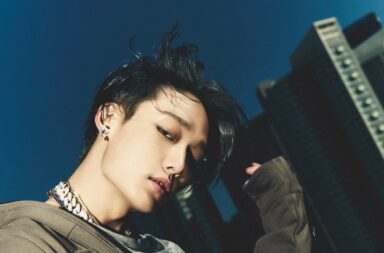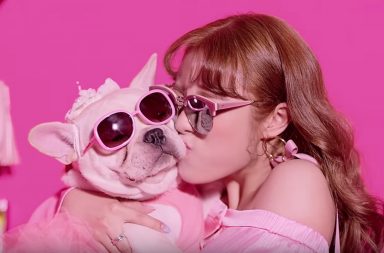 Expectations were high when YG announced Masta Wu, Dok2 and iKON’s Bobby as the second collaboration of its Hip Hop Project. While the inclusion of Masta Wu and Dok2 came as a surprise, the trio collaboration was welcomed by many fans. As opposed to their lackluster collaboration of their predecessors, GD and Taeyang with “Good Boy,” the three rappers did not disappoint.
Expectations were high when YG announced Masta Wu, Dok2 and iKON’s Bobby as the second collaboration of its Hip Hop Project. While the inclusion of Masta Wu and Dok2 came as a surprise, the trio collaboration was welcomed by many fans. As opposed to their lackluster collaboration of their predecessors, GD and Taeyang with “Good Boy,” the three rappers did not disappoint.
[youtube http://www.youtube.com/watch?v=yiK9Hnxlgrk]
A great strength of the rap track stems from the fact that it is a remix of a Masta Wu classic. Masta Wu, although only having released two albums since signing with YG in 2003, is no stranger to the K-hip hop community. In fact, he is one of it’s most revered seniors. Although Masta Wu has been in the public eye with the rapping competition Show Me the Money (where he worked with both Dok2 and Bobby), “Come Here” marks his first official musical release in over 6 years.
The music video for “Come Here,” seems to have been produced more out of necessity than a true desire to visually express the song, but that doesn’t negate its appeal. Yes, it is filled with many hip hop cliches that have become almost laughable a this point, but it also is filled with playful moments that stand in sharp contrast to the aggression of the track. The combination of slight humor and confusion alongside a rather hard rap track gives the track and music video package an unique edge.
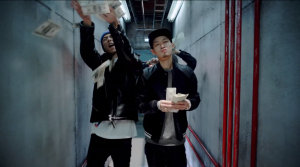 It seems no hip hop MV would be complete without a mandatory set of cliches, so let’s get those out of the way early. Yes, the trio are all wearing grills. Yes, Dok2 throws money at the screen. There’s a random car, gold chains and ski masks. Of course, there is a scantily-clad female present throughout the entire video who acts more as a prop than a character. These aspects of the video should not be entirely overlooked, as they demonstrate the consistent problematic ideals of K-hip hop. However, I’m not entirely convinced the music video is meant to be taken seriously.
It seems no hip hop MV would be complete without a mandatory set of cliches, so let’s get those out of the way early. Yes, the trio are all wearing grills. Yes, Dok2 throws money at the screen. There’s a random car, gold chains and ski masks. Of course, there is a scantily-clad female present throughout the entire video who acts more as a prop than a character. These aspects of the video should not be entirely overlooked, as they demonstrate the consistent problematic ideals of K-hip hop. However, I’m not entirely convinced the music video is meant to be taken seriously.
The video begins with a jarring photomontage accompanied by an air horn and a close shot of Masta Wu’s grills as he begins to rap the familiar chorus, beckoning the haters to “Come Here.” There’s also the female character whose face is half obscured as she wields a baseball bat.
Korean hip hop’s present champion, Dok2, kicks off the track and music video with his self-composed verse. Although Dok2 is not a stranger to YG collaborations, the inclusion of the Illionaire rapper is significant in showing YG’s openness to outside collaborations. Out of the three participants, I was least excited for Dok2 going into the track, and his verse did little to change my opinion. As I watched him throw money purposelessly at the camera, I wondered when the show would get on the road. This is not to say his verse is horrible, in fact it’s far from it, but there is little that is distinctive about his style. Perhaps it’s also that his verse is accompanied by the most cliche visuals, whereas Bobby and Masta Wu are featured with more interesting aesthetics.
Bobby’s verse falls in the middle of the track. Sometimes it’s hard to tell whether Bobby is rapping or growling, but that style suits the in-your-face nature of “Come Here.” The beat builds to a change-up sort of climax mid-verse and Bobby’s rap builds with it, providing an effective change of pace to what otherwise could have been an overly-monotonous beat. Even as a rookie, Bobby’s skill is apparent as he carries the middle of the track and builds up the anti for Masta Wu’s verse.
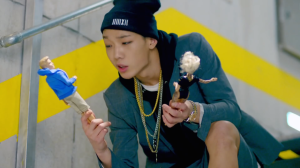 While Bobby’s lyrics are mature and aggressive, the visual aspect of the MV seems infatuated with his youth (almost to the point of portraying him as infantile). The rookie is displayed drinking milk from a carton, riding a rocking toy and playing with tattooed barbie dolls. While the other rappers in the video boast gold chains, expensive modern art pieces and cars, Bobby gets to ride a bicycle. However, Bobby begins to mature: while drinking from the milk carton he notices a woman’s breasts (more like ogles), and while playing with the dolls, he tosses Ken aside in favor of keeping Barbie to himself.
While Bobby’s lyrics are mature and aggressive, the visual aspect of the MV seems infatuated with his youth (almost to the point of portraying him as infantile). The rookie is displayed drinking milk from a carton, riding a rocking toy and playing with tattooed barbie dolls. While the other rappers in the video boast gold chains, expensive modern art pieces and cars, Bobby gets to ride a bicycle. However, Bobby begins to mature: while drinking from the milk carton he notices a woman’s breasts (more like ogles), and while playing with the dolls, he tosses Ken aside in favor of keeping Barbie to himself.
These little touches are humorous but they also point to a more significant representation: Bobby is the new blood to the hip hop community, and compared to his peers, Masta Wu and Dok2, he is a maturing child. He’s playing with the big boys now, but that doesn’t detract from his overwhelming youth in comparison to his two seniors.
Finally, in the last minute or so of the track, Masta Wu finally takes the mic. Masta Wu seems exceedingly comfortable on this track. As the senior of the group, he very well could have rested on his laurels, but instead he chose to produce a verse that — while maintaining the mood of his original track — displays both his confidence and proficiency in rap, without trying too hard. Whereas his original lyrics were littered with anger and slurs, the remix version shows Masta Wu in a more laid back position of authority, as if he is daring anyone to challenge him.
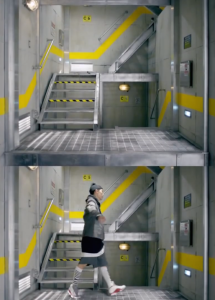 The aesthetic aspect of the MV is sharp and clean. While most of the sets stick to simple black, grey, and white; contrasts of gold, yellow, and red props litter each frame. As the MV gains steam, red and teal become more and more prominent. By Master Wu’s verse, he is featured in a vibrant red room. The grey warehouse staircase set had potential to be mundane; however, the set is brought to life in the way the three rappers (primarily Bobby) utilize the space. The rappers’ progression from the upper tiers to the ground level give a sense of dimension that the MV would have sorely been lacking otherwise.
The aesthetic aspect of the MV is sharp and clean. While most of the sets stick to simple black, grey, and white; contrasts of gold, yellow, and red props litter each frame. As the MV gains steam, red and teal become more and more prominent. By Master Wu’s verse, he is featured in a vibrant red room. The grey warehouse staircase set had potential to be mundane; however, the set is brought to life in the way the three rappers (primarily Bobby) utilize the space. The rappers’ progression from the upper tiers to the ground level give a sense of dimension that the MV would have sorely been lacking otherwise.
There are several elements that detract from the potential of the music video. The photo montages interspersed throughout the video felt almost disruptive and disorienting. They flashed too quickly to process and succeeded in little more than jarring the audience. Additionally, the use of the female body as a prop was problematic, especially when the women are presented as faceless and practically unconscious.
Overall, the best feature of the music video — despite all the predictable cliches– is that the MV maintains that YG sense of playfulness that prevents the audience from taking it too seriously. Aesthetically, there were several moments where I felt I was watching a GDTOP MV circa 2010. More than anything, there is humor in the excess (as well as a few head-scratching moments). Why are their women wearing George Bush and Barack Obama masks? Why is Bobby on a children’s rocking toy? Was that Teddy I just saw? Yes, it was. Isn’t it dangerous to ignite a smoke bomb indoors?! It’s these little touches that keep the viewer engaged (and concerned), and spice up what could have been a very generic rap video.
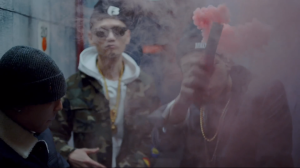 Remixing a Masta Wu classic was a safe bet for a collaboration. Although Teddy co-produced this version as well, with the inclusion of Dok2 and Bobby, there are very few remnants of the original track, which brought me relief, considering the original featured an offensive slur not dissimilar to the one Zico came under fire for using. The hypnotic feel of the original track was abandoned in favor of a harder beat, and of course the dreaded air horn. Lyrically, the track maintains it’s original confrontational content, as the three rappers alternate between boasting and challenging their haters.
Remixing a Masta Wu classic was a safe bet for a collaboration. Although Teddy co-produced this version as well, with the inclusion of Dok2 and Bobby, there are very few remnants of the original track, which brought me relief, considering the original featured an offensive slur not dissimilar to the one Zico came under fire for using. The hypnotic feel of the original track was abandoned in favor of a harder beat, and of course the dreaded air horn. Lyrically, the track maintains it’s original confrontational content, as the three rappers alternate between boasting and challenging their haters.
Overall, the track introduces (and re-introduces) listeners the past, present and future of the Korean rap scene. It’s a collaborative remix done well, and I admit to being disappointed when the track suddenly ended. While it’s nothing outstanding, it is the kind of song that makes me want to follow it up with some “Born Hater” before I go take on the world.
Song: 3.5/5
MV: 3/5
Readers: How did you feel about the second collaboration of YG’s Hip Hop Project? Were you excited about the return of Masta Wu?

